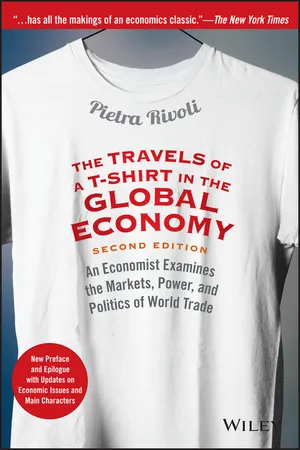1
How America Has Dominated the Global Cotton Industry for 200 Years
Reinsch Cotton Farm Smyer, Texas
Unlike French wine or Florida oranges, Texas cotton doesn't brag about where it was born and raised. Desolate, hardscrabble, and alternately baked to death, shredded by windstorms, or pummeled by rocky hail, west Texas will never have much of a tourist trade. Flying into the cotton country near Lubbock on a clear fall day, I had a view of almost lunar nothingness: no hills, no trees. No grass, no cars. No people, no houses. The huge and flat emptiness is jarring and intimidating at first, since one can't help but feel small and exposed in this landscape. Though I had traveled to dozens of countries and to almost every continent, during my first visit to Lubbock, Texas, I thought it was one of the most foreign places I had ever been. Somehow, since then, it has also become one of my favorite places. There is a very good chance that my T-shirt—and yours—was born near Lubbock, the self-proclaimed ‘‘cottonest city'’ in the world.
The people of this forbidding yet harshly beautiful place are well-suited to the landscape. Indeed, they are the product of it. The land has humbled them with its unpredictable temperament and its sheer scale, yet made them proud of each small success in taming and coaxing from it the fluffy white gold of the cotton plant. According to local legend, when God created west Texas, He made a mistake and forgot to fashion hills, valleys, rivers, and trees. Looking at His desolate and barren mistake, He considered starting over, but then had another idea. ‘‘I know what I'll do,’’ He said. ‘‘I'll just create some people who like it this way.’'
And so He did.
Nelson Reinsch, cotton farmer, still stands tall and handsome at the age of 87. He laughs easily but speaks carefully. He calls his wife, Ruth, ‘‘Sugar,’’ and every other woman ‘‘Ma’am.'’ Nelson is a gentleman in the older sense of the word, well-mannered and considerate from the inside. We last met in 2008, and, remarkably, Nelson seemed not to have aged a bit since our first meeting in 2000.
In his 87 years, Nelson has missed four cotton harvests, all of them during his Navy service in World War II. Nelson and Ruth are happy enough (or perhaps just polite enough) to talk about the past if that is what their guests want to hear about. But they wallow not one bit in ‘‘the good old days,’’ and their minds are opening rather than closing as they approach the ends of their lives. The world is still very interesting to Nelson and Ruth Reinsch. Of the many places and people I have visited during the research for this book, among my favorite times have been sitting in the Reinsch kitchen, eating (too much) of Ruth's cake and learning about cotton. In 2008, Nelson and Ruth remained on their farm in the middle of the west Texas emptiness. However, in that year Nelson scaled back his cotton operation and began to rent out much of his land.
Producing cotton is no longer the backbreaking physical process it once was, but every year Nelson and Ruth still battle both the whims of nature and the vagaries of markets. Each summer they take on the wind, sand, heat, and insects; and each fall, at harvest, they take on the world markets, in which they compete with cotton farmers from over 70 countries. The Reinsches' 1,000 acres can produce about 500,000 pounds of cotton lint if fully planted, enough for about 1.3 million T-shirts. That Nelson is ending his life in the same occupation in which he began tells us much about him. It also tells us much about the U.S. cotton industry.
History shows that almost all dominance in world markets is temporary and that even the most impressive stories of national industrial victories typically end with sobering postscripts of shifting comparative advantage. Within the baby boomers' lifetime, preeminence in consumer electronics has shifted from the United States to Japan to Hong Kong to Taiwan to China. Apparel production has moved from the American South to Southeast Asia to the Caribbean and back to Asia. Advantages in steel have moved from the U.S. Rust Belt to Japan to South Korea. But for over 200 years, the United States has been the undisputed leader in the global cotton industry in almost any way that can be measured, and other countries, particularly poor ones, have little chance of catching up. The United States has historically occupied first place in cotton production (though recently second to China), cotton exports (though occasionally second to Uzbekistan), farm size, and yields per acre.1
On the surface, cotton is an unlikely candidate for economic success in the United States. Typically, American industries compete with those in ‘‘like'’ countries. U.S. firms compete with Japanese automakers, German chemical companies, and Swiss pharmaceuticals. But for climatic reasons, few advanced industrial economies produce cotton. Instead, American cotton growers compete with producers in some of the world's poorest and least developed regions. If our labor costs—among the world's highest—have toppled or relocated industries as diverse as apparel, steel, and shipbuilding, how has U.S. cotton maintained its world dominance?
More broadly, how can an industry so basic and ‘‘downstream'’ as cotton production continue to thrive in an advanced, service-oriented economy? There would appear to be little sustainable advantage in an industry such as cotton. Models of business strategy would predict that dominance in such an industry can only be fleeting and stressful: The lack of product differentiation, the intense price competition, and the low barriers to entry make it scarcely worth the trouble. Business professor and strategist Michael Porter notes that:
advantages [are] often exceedingly fleeting [in these industries].... Those industries in which labor costs or natural resources are important to competitive advantage also often have... only low average returns on investment. Since such industries are accessible to many nations... because of relatively low barriers to entry, they are prone to too many competitors.... Rapidly shifting factor advantage continually attracts new entrants who bid down profits and hold down wages.... Developing nations are frequently trapped in such industries.... Nations in this situation will face a continual threat of losing competitive position....2
While this description of life on the economic precipice rings true for poor cotton farmers in South Asia and Africa, it does not describe the cotton industry around Lubbock. Year in and year out, American cotton farmers, as a group, are on top. What explains American cotton's success as an export commodity in a country that has experienced a merchandise trade deficit in each year since 1975? And what explains U.S. cotton producers' ability to export such a basic commodity to much poorer countries? Why here? Why was my Chinese T-shirt born in Texas?
Oxfam, the international development organization, believes it has the answer. According to a number of scathing Oxfam reports, the comparative advantage enjoyed by U.S. cotton farmers lies in their skill at collecting government subsidies.3 In the fall of 2003, bolstered by Oxfam's research and resources, the poorest countries in the world cried foul against the richest at the opening of the World Trade Organization (WTO) trade talks in Cancun, Mexico. Tiny, desperately poor countries such as Benin and Burkina Faso stood firm and stared down U.S. negotiators: They charged that U.S. cotton subsidies were blocking their route out of poverty, and that it was impossible to compete with Uncle Sam's largesse to U.S. cotton farmers. In a soundbite that carried considerable punch, the poor countries pointed out that U.S. cotton subsidies exceeded the entire GDP of a number of poor cotton-producing countries in Africa. If the United States was going to champion the case for free trade, Americans needed to walk the walk as well as talk the talk. The stare-down continued for several tortured days until the talks collapsed and both rich and poor gave up and went home.4 The point, however, had been made, and several months later the WTO ruled that U.S. cotton subsidies violated global trade rules and unfairly tilted the playing field toward American producers. In the summer of 2004, with the huge subsidies in the public spotlight, U.S. trade negotiators agreed not only to put cotton subsidies on the table, but to tackle the cotton issue ‘‘ambitiously, expeditiously, and specifically'’ during the Doha Round of trade negotiations.5 As of the fall of 2008, however, the negotiations remained stalled, with most of the subsidies still in place.
There is no doubt that the subsidies are big and little doubt that they are unfair to poor countries. But anyone who believes that America's competitive power in the global cotton industry reduces to government subsidies should spend some time near Lubbock, Texas. While the subsidies are, of course, a boon to U.S. producers, the success of cotton growers such as Nelson Reinsch is a much more complex phenomenon.
First, the dominance of the U.S. industry predates by well over a century the implementation of national farm subsidies. As Chapter 2 describes, the U.S. cotton industry passed its competitors over 200 years ago. Therefore, while subsidies may account for some cost advantages today, they cannot ...

